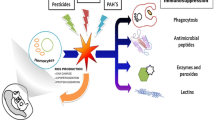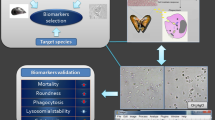Abstract
The shellfish industry is an important economic activity in France, occurring mostly in estuarine zones subject to pollution due to anthropogenic activities. The harmful effects of pollutants on species inhabiting these estuarine zones are not well known. Among marine species, bivalve mollusks---particularly Pacific oyster, Crassostrea gigas---may serve a model of interest. The species is sedentary and filter-feeding, which favors bioaccumulation of pollutants in their tissues. Oysters may be suitable for studies on disturbance by pollutants of physiological activities, among which defense mechanisms are poorly documented in bivalves. In this study, effects of pollutants on hemocyte functions were monitored in Pacific oyster, C. gigas. Hemocytes were exposed in vitro to selected pollutants. The strategy for investigating the effects of pollutants on hemocyte functions is based on several biomarkers, which is more relevant than that of published papers based on single-endpoint experiments. Pollutants belonging to the most important groups of xenobiotics (PAHs, PCBs, and pesticides) were selected and their effect on hemocyte activities was analyzed using flow cytometry. Twenty-three pollutants were tested and eight of them showed significant modulation of hemocyte activities. PAHs and PCB 77 induced a decrease of hemocyte activity after an incubation periods of 4 and 24 h at 200 μmol/L. Three pesticides (2,4D, paraoxon, and chlorothalonil) modulated hemocyte activities. A mixture of eight pesticides also decreased phagocytotic activity. This study is one of the first to investigate the effects of so many pollutants on hemocyte functions at the same time and therefore allows a real comparison of different pollutant effects
Similar content being viewed by others
Abbreviations
- ASW:
-
artificial seawater
- BaP:
-
benzo(a)pyrene
- DHR123:
-
dihydrorhodamine 123
- 2,4D:
-
2,4-dichlorophenoxyacetic acid
- FDA:
-
fluorescein diacetate
- PAHs:
-
polycyclic aromatic hydrocarbons
- PCBs:
-
polychlorinated biphenyls
- PCP:
-
pentachlorophenol
- PI:
-
propidium iodide
- ROS:
-
reactive oxygen species
References
Alvarez MR, Friedl FE. Effects of a fungicide on in vitro hemocyte viability, phagocytosis and attachment in the American oyster, Crassostrea virginica. Aquaculture. 1992;107:135–40.
Anderson RS. Effects of carcinogenic and noncracinogenic environmental pollutants on immunological functions in a marine invertebrtae. In: Dawe CJ, eds. Phyletic approaches to cancer. Tokyo: Japan Sci. Soc. Press; 1981:319–31.
Anderson RS. Hemocyte-derived reactive oxygen intermediate prodution in four bivalve mollusks. Dev Comp Immunol. 1994;18:89–96.
Anderson RS, Oliver LM, Jacobs D. Immunotoxicity of cadmium for the eastern oyster (Crassostrea virginica (Gmelin, 1791)): effects on hemocyte chemiluminescence. J Shellfish Res. 1992;11:31–5.
Anderson RS, Burreson EM, Paynter KT. Defense responses of hemocytes withdrawn from Crassostrea virginica infected with Perkinsus marinus. J Invertebr Pathol. 1995;66:82–9.
Auffret M, Oubella R. Hemocyte aggregation in the oyster Crassostrea gigas: in vitro measurement and experimental modulation by xenobiotics. Comp Biochem Physio A. 1997;118:705–12.
Auffret M, Mujdzic N, Corporeau C, Moraga D. Xenobiotic-induced immunomodulation in the European flat oyster, Ostrea edulis. Mar Environ Res. 2002;54:585–89.
Baier-Anderson C, Anderson RS. The effect of pentachlorophenol on NADPH production in oyster hemocytes; immunomodulatory consequences. J Shellfish Res. 1996;15:498–9.
Baier-Anderson C, Anderson RS. The effects of chlorothalonil on oyster hemocyte activation. Phagocytosis, reduced pyridine nucelotides, and reactive oxygen species production. Environ Res. 2000;83:72–8.
Bocquene G, Roig A, Fournier D. Cholinesterases from the common oyster (Crassostrea gigas). Evidence for the presence of a soluble acetylcholinesterase insensitive to organophosphate and carbamate inhibitors. FEBS Lett. 1997;407:261–6.
Bouilly K, Leitao A, McCombie H, Lapegue S. Impact of atrazine on aneuploidy in pacific oysters, Crassostrea gigas. Environ Toxicol Chem. 2003;22:219–23.
Brousseau P, Pellerin J, Morin Y, et al. Flow cytometry as a tool to monitor the disturbance of phagocytosis in the clam Mya arenaria hemocytes following in vitro exposure to heavy metals. Toxicology. 2000;142:145–56.
Canesi L, Ciacci C, Betti M, et al. Effects of PCB congeners on the immune function of Mytilus hemocytes: alterations of tyrosine kinase-mediated cell signaling. Aquat Toxicol. 2003;63:293–306.
Cheng TC. Bivalves. In: Ratcliffe NA and Rowley AF, eds. Invertebrate blood cells I. London: Academic Press; 1981:233–99.
Cheng TC, Sullivan JT. Effects of heavy metals on phagocytosis by molluscan hemocytes. Mar Environ Res. 1984;14:305–15.
Cheng TC, Mohandas A, Sullivan JT. In vivo effects of heavy metals on cellular immunity in molluscs. In: Dorignan JV an Harrison FL, eds. Physiological responses of marine organisms to environmental stressors; 1987:59–62.
Christin MS, Menard L, Gendron AD, et al. Effects of agricultural pesticides on the immune system of Xenopus laevis and Rana pipiens. Aquat Toxicol. 2004;67:33–43.
Chu FL, Volety AK, Hale RC, Huang. Y. Cellular responses and disease expression in oysters (Crssostrea virginica) exposed to suspended field contaminated sediments. Mar Environ Res. 2002;53:17–35.
Coles JA, Farley SR, Pipe RK. Effects of fluoranthene of the immunocompetence of the common marine mussel, Mytilus edulis. Aquat Toxicol. 1994;30:367–79.
Coles JA, Farley SR, Pipe RK. Alteration of the immune response of the common marine mussel Mytilus edulis resulting from exposure to cadmium. Dis Aquat Organ. 1995;22:59–65.
Cooreman K, Roose P, Vyncke W. Screening of organophosphate and carbamate pesticides by cholinesterase inhibition. In: ICES Marine Environmental Quality Committee, eds. ICES Statutory Meeting 1993. Copehagen: ICES; 1993:1–7.
Coteur G, Danis B, Fowler SW. Teyssie JL, Dubois P, Warnau M. Effects of PCBs on reactive oxygen species (ROS) prodution by the immune cells of Paracentrotus lividus (Echinodermata). Mar Pollut Bull. 2001;42:667–72.
Faust M, Altenburger R, Backhaus T, et al. Predicting the joint algal toxicity of multi-component s-triazine mixtures at low-effect concentrations of individual toxicants. Aquat Toxicol. 2001:56:13–32.
Fisher SW. Structure and functions of oyster hemocytes. In: Brehélin M, eds. Immunity in invertebrates. Berlin Heidelberg; Springer; 1986:25–35.
Fisher WS, Auffret M, Balouet G. Response of European flat oyster (Ostrea edulis) hemocytes to acute salinity and temperature changes. Aquaculture, 1987;67:179–90.
Fournier M, Chevalier G, Nadeau D, Trottier B, Krzystyniak K. Virus–pesticide interactions with murine cellular immunity after sublethal exposure to dieldrin and aminocarb. J Toxicol Environ Health A. 1988;25:103–18.
Fournier M, Pellerin J, Clermont Y, Morin Y, Brousseau P. Effects of in vivo exposure of Mya areanria to organic and inorganic mercury on phagocytic activity of hemocytes. Toxicolgoy. 2001;161:201–11.
Fournier M, Pellerin J, Lebeuf M, Brousseau P, Morin Y, Cyr D. Effects of exposure of Mya arenaria and Mactromeris polynyma to contaminated marine sediments on phagocytic activity of hemocytes. Aquat Toxicol. 200;59:83–92.
Gagnaire B, Renault T, Bouilly K, Lapegue S, Thomas-Guyon H. Study of atrazine effects on Pacific oyster, Crassostrea gigas, haemocytes. Curr Pharm Design. 2003;9:193–9.
Gagnaire B, Thomas-Guyon H, Renault T. In vitro effects of cadmium and mercury on Pacific oyster, Crassostrea gigas (Thunberg), haemocytes. Fish Shellfish Immunol. 2004;16:501–12.
Galloway TS, Millward N, Browne MA, Depledge MH. Rapid assessment of organophosphorus/carbamate exposure in the bivalve mollusc Mytilus edulis using combined esterase activites as biomarkers. Aquat Toxicol. 2002;61:169–80.
Goedken M, De Guise S. Flow cytometry as a tool to quantify oyster defence mechanisms. Fish Shellfish Immunol. 2004;16:539–52.
Gomez-Mendikute A, Etxeberria A. Olabarrieta I, Cajaraville MP. Oxygen radicals production and actin filament disruption in bivalve haemocytes treated with benzo(a)pyrene. Mar Environ Res. 2002;54:431–6.
Grizel H, Hearl M. Introduction into France of the Japanese oyster (Crassostrea gigas). ICES J Mar Sci. 1991;47:399–403.
Harper N, Connor K, Steinberg M, Safe S. Immunosuppressive activity of polychlorinated biphenyl mixtures and congeners: nonadditive (antagonistic) interactions. Fundam App Toxicol. 1995;27:131–9.
Harvell CD, Kim K, Burkholder JM, et al. Emerging marine diseases—climate links and anthropogenic factors. Science. 1999;285:1505–10.
Lacoste A, Malham SK, Gelebart F, Cueff A, Poulet SA. Stress-induced immune changes in the oyster Crassostrea gigas. Dev Comp Immunol. 2002;26:1–9.
Lambert C, Sodant P, Choquet G, Paillard C. Measurement of Crassostrea gigas hemocyte oxidative metabolism by flow cytometry and the inhibting capacity of pathogenic vibrios. Fish Shellfish Immunol. 2003;15:225–40.
Larson KG, Roberson BS, Hetrick FM. Effect of environmental pollutants on the chemiluminescence of hemocytes from the American oyster Crassostrea virginica. Dis Aquat Organ 1989;6:131–6.
Léonard S. Réseau Régional de suivi de la qualité des eaux vis-à-vis des produits phytosanitaires. Fédération régionale de défense contre les organismes nuisibles de Poitou-Charentes, 2002:57.
Lioi MB. Scarfi MR. Santoro A, et al. Genotoxicity and oxidative stress induced by pesticide exposure in bovine lymphocyte cultures in vitro. Mutat Res Fundam Mol Mech Mutagen. 1998;403:13–20.
Livingstone DR. The fate of organic xenobiotics in aquatic ecosystems: quantitative and qualitative differences in biotransformation by invertebrates and fish. Comp Biochem Physiol. A Mol Integr Physiol. 1998;120:43–9.
Lowe DM, Soverchia C, Moore MN. Lysosomal membrane responses in the blood and digestive cells of mussels experimentally exposed to fluoranthene. Aquat Toxicol. 1995;33:105–12.
Lowe DM, Fossato VU. The influence of environmental contaminants on lysosomal activity in the digestive cells of mussels (Mytilus galloprovincialis) from the Venice Lagoon. Aquat Toxicol. 2000;48:75–85.
Moore CA, Gelder SR. Demonstration of lysosomal enzymes in hemocytes of Mercenaria mercenaria (Mollusca: Bivalvia). Trans Am Microsc Soc. 1985;104:242–9.
Moore MN, Lowe, DM, Fieth PEM. Lysosomal responses to experimentally injected anthracene in the digestive cells of Mytilus edulis. Mar 1978;48:297–302.
Moore MN. Biocomplexity: the post-genome challenge in ecotoxicology. Aquat Toxicol. 2002;59:1–15.
Oliver LM, Fisher WS, Winstead JT, Hemmer BL, Long ER. Relationships between tissue contaminants and defense-related characteristics of oysters (Crassostrea virginica) from five Florida bays. Aquat Toxicol. 2001;55:203–22.
Oubella R, Maes P, Paillard C, Auffret M. Experimentally induced variation in hemocyte density for Ruditapes philippinarum and R. decussatus (Mollusca, Bivalvia). Dis Aquat Organ. 1993;15:193–7.
Oubella R, Auffret M. Immuno-modulation in populations of mollusc bivalves from the Brest Roadsted. Acte de Rencontre Scientifique International. 1995;1:307–19.
Ozretic B, Krajnovic-Ozretic M. Esterase heterogeneity in mussel Mytilus galloprovincialis: effects of organophosphate and carbamate pesticides in vitro. Comp Biochem Physiol C Comp Pharmacol. 1992;103:221–5.
Pipe RK, Coles JA. Environmental contaminants influencing immune function in marine bivalve molluscs. Fish Shellfish Immuno 1995;5:581–95.
Pipe RK, Coles JA, Thomas ME, Fossato VU, Pulsford AL. Evidence for environmentally derived immunomodulation in mussels from the Venice Lagoon. Aquat Toxicol. 1995;32:59–73.
Pipe RK, Coles JA, Carissan FMM, Ramanathan K. Copper induced immunomodulation in the marine mussel, Mytilus edulis. Aquat Toxicol. 1999;46:43–54.
Sami S, Faisal M, Huggett RJ. Effects of laboratory exposure to sediments contaminated with polycyclic aromatic hydrocarbons on the hemocytes of the American oyster Crassostrea virginica. Mar Environ Res 1993;35:131–5.
Sauve S, Brousseau P, Pellerin J, et al. Phagocytic activity of marine and freshwater bivalves: in vitro exposure of hemocytes to metals (Ag, Cd, Hg and Zn). Aquat Toxicol. 2002a;58:189–200.
Sauve S, Hendawi M, Brousseau P, Fournier M. Phagocytic response of terrestrial and aquatic invertebrates following in vitro exposure to trace elements. Ecotoxicol Environ. Safe. 2002b;52:21–9.
Tripp MR. Effects of organophosphate pesticides on adult oysters (Crassostrea virginica). In: Vernberg FJ and Vernberg WB, eds. Pollution and physiology of marine organisms. New York: Academic Press; 1971:225–36.
Wade TL, Sericano JL, Gardinali PR, Wolff G, Chambers L. NOAA's ‘Mussel Watch Project: current use organic compounds in bivalves. Mar Pollut Bull. 1998;37:20–6.
Wootton EC, Dyrynda EA. Pipe RK, Ratcliffe NA. Comparisons of PAH-induced immunomodulation in three bivalve molluscs. Aquat Toxicol. 2003;65:13–25.
Xue QG, Renault T, Chilmonczyk S. Flow cytometric assessment of haemocyte sub-populations in the European flat oyster, Ostrea edulis, haemolymph. Fish Shellfish Immunol. 2001;11:557–67.
Author information
Authors and Affiliations
Corresponding author
Rights and permissions
About this article
Cite this article
Gagnaire, B., Thomas-Guyon, H., Burgeot, T. et al. Pollutant effects on Pacific oyster, Crassostrea gigas (Thunberg), hemocytes: Screening of 23 molecules using flow cytometry. Cell Biol Toxicol 22, 1–14 (2006). https://doi.org/10.1007/s10565-006-0011-6
Received:
Accepted:
Issue Date:
DOI: https://doi.org/10.1007/s10565-006-0011-6




